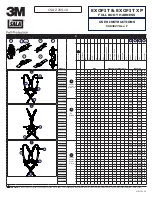
5.6 Other Considerations
5.6.1 Adjacent Reflective Surfaces
A reflective surface located adjacent to the defined area may deflect one or more beams around an object in the defined
area. In the worst case, an optical short circuit may occur, allowing an object to pass undetected through the defined area.
WARNING:
•
Do not install the system near reflective surfaces
•
Reflective surfaces could reflect the sensing beam(s) around an object or person within the
defined area, preventing detection by the system. Failure to prevent reflection problems results in
incomplete guarding and an optical short circuit that could result in serious injury or death.
•
Do not locate the defined area near a reflective surface. Perform the trip test, as described in the
product documentation, to detect such reflection(s).
This reflective surface may result from shiny surfaces or glossy paint on the machine, the workpiece, the work surface, the
floor, or the walls. Beams deflected by reflective surfaces are discovered by performing the trip test and the periodic checkout
procedures. To eliminate problem reflections:
•
If possible, relocate the sensors to move the beams away from the reflective surface(s) (see
being careful to maintain adequate Safety Distance (Minimum Distance)
•
Otherwise, if possible, paint, mask, or roughen the shiny surface to reduce its reflectivity
•
Where these are not possible (as with a shiny workpiece or machine frame), determine the worst-case resolution (see
on page 20) resulting from the optical short circuit and use the corresponding depth penetration factor (D
pf
or C) in the Safety Distance (Minimum Distance) formula (see
Calculating the Safety Distance (Minimum Distance)
page 15); or mount the sensors in such a way that the receiver's field of view and/or the emitter's spread of light are
restricted from the reflective surface
•
Repeat the trip test (see
Trip Test
on page 30) to verify these changes have
eliminated the problem reflection(s). If the workpiece is especially reflective and comes close to the defined area,
perform the trip test with the workpiece in place
Figure 5. Adjacent Reflective Surfaces
d
d
d
Operating Range (R)
Emitter
Receiver
Do not position reflective
surfaces within the shaded area
top view
side view
Reflective Surface
Reflective Surface
Operating range 0.1 m to 3 m (4 in to 10 ft): d = 0.13 m (5 in)
Operating range > 3 m (>10 ft): d = 0.0437 × R (m or ft)
Figure 6. Determining Worst-Case Resolution With Larger Test Piece
Reflective Surface
If an optical short circuit exists due to a reflective adjacent surface, a test piece (represented by the dark gray circle) with the
specified system resolution will not cause a blocked condition. In this situation, during the Trip Test, the Zone indicators and
Status indicator will be green and the OSSDs will be on.
S4B Safety Light Curtain
20
www.bannerengineering.com - Tel: + 1 888 373 6767
















































